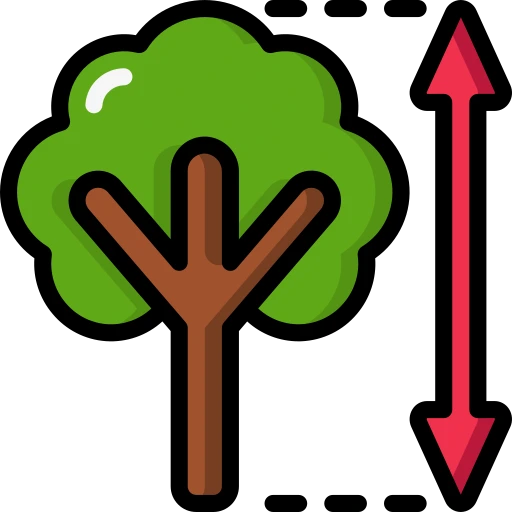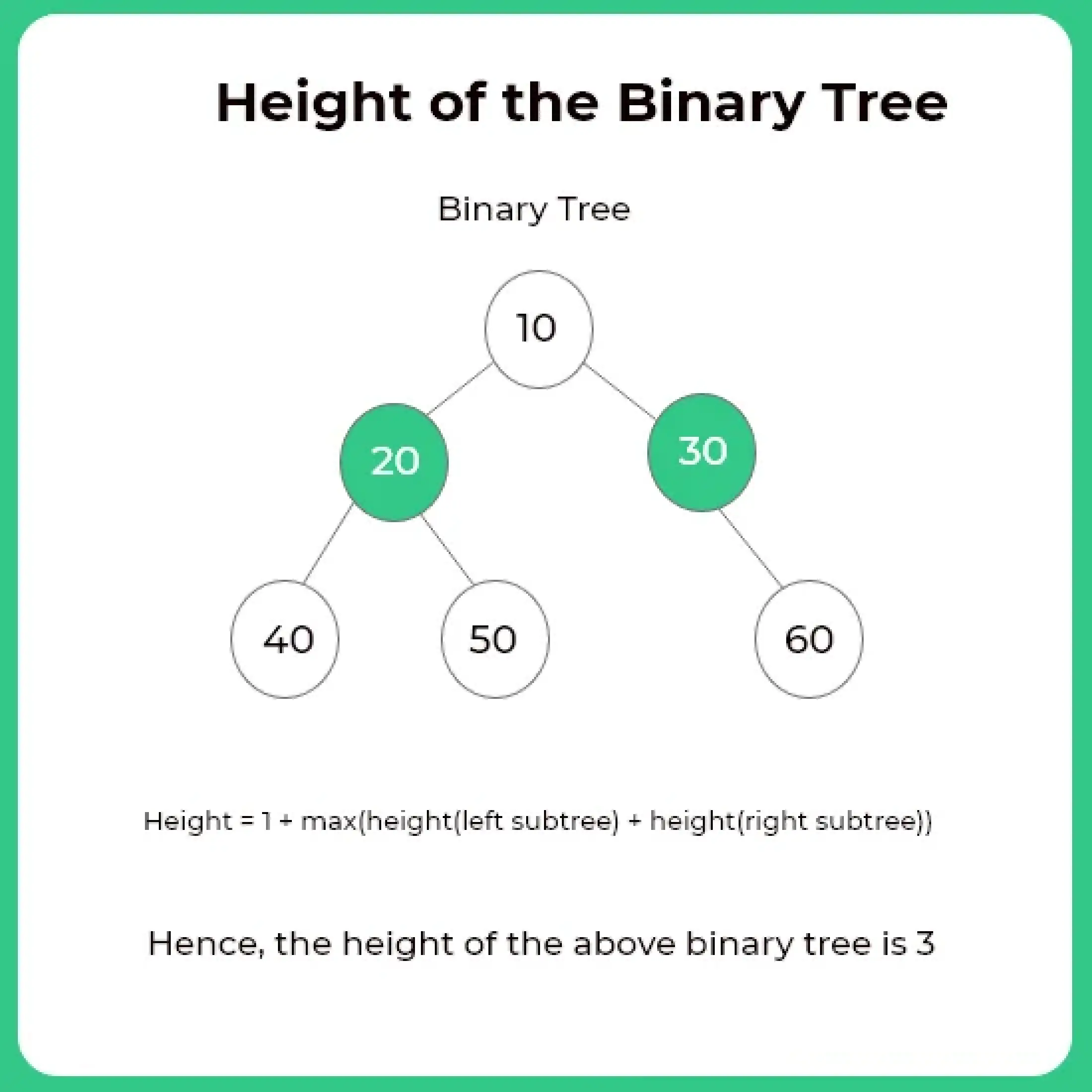0
Notifications Mark All Read
- Login
- Get Prime
Height Of A Binary Tree in C++
Height Of The Tree
The height of a binary is tree is defined as the number of edges between the root node and the farthest leaf node.The height of an empty tree is 0 and height of the tree given in the image is 3.

Common Uses Of Finding Height Of Tree
- To check whether the tree is an AVL tree or not. An AVL tree is a binary search tree in where the difference of left and right subtree is less than or equal to one for all nodes.
- To Print Level Order Traversal using recursion.
- The number of nodes in a perfect binary tree can be determined using height of the tree.
Algorithm:
- If root is NULL, return 0.
- Otherwise Recursively call the height function on its left and right child.
- Return the value which is greater out of height of left child and bight of right child

Code Implementation to find height of a Binary Tree in C++
Run
#include<bits/stdc++.h>
using namespace std;
struct Node
{
int data;
Node *left;
Node *right;
};
// Function to create a new node
Node * newNode (int data)
{
Node *node = new Node;
node->data = data;
node->left = nullptr;
node->right = nullptr;
return node;
}
// Function to find the height of a binary tree
int height (Node * root)
{
if (root == nullptr)
{
return 0;
}
else
{
int left_height = height (root->left);
int right_height = height (root->right);
return 1 + max (left_height, right_height);
}
}
int main ()
{
// Create a binary tree
Node *root = newNode (1);
root->left = newNode (2);
root->right = newNode (3);
root->left->left = newNode (4);
root->left->right = newNode (5);
// Find the height of the binary tree
cout << "Height of the binary tree is " << height (root) << endl;
return 0;
}
Output: Height of the Binary Tree is 3
Prime Course Trailer
Related Banners
Get PrepInsta Prime & get Access to all 200+ courses offered by PrepInsta in One Subscription
Introduction to Trees
Binary Trees
- Binary Tree in Data Structures (Introduction)
- Tree Traversals: Inorder Postorder Preorder : C | C++ | Java
- Inorder Postorder PreOrder Traversals Examples
- Tree Traversal without Recursion
Binary Search Trees
Traversals
- Traversal in Trees
- Tree Traversals: Breadth-First Search (BFS) : C | C++ | Java
- Tree Traversals: Depth First Search (DFS) : C | C++ | Java
- Construct a Binary Tree from Postorder and Inorder
B – Trees
AVL Trees
- AVL Trees
Complete Programs for Trees
- Depth First Traversals – C | C++ | Java
- Level Order Traversal – C | C++ | Java
- Construct Tree from given Inorder and Preorder traversals – C | C++ | Java
- Construct Tree from given Postorder and Inorder traversals – C | C++ | Java
- Construct Tree from given Postorder and Preorder traversal – C | C++ | Java
- Find size of the Binary tree – C | C++ | Java
- Find the height of binary tree – C | C++ | Java
- Find maximum in binary tree – C | C++ | Java
- Check whether two tree are identical- C| C++| Java
- Spiral Order traversal of Tree- C | C++| Java
- Level Order Traversal Line by Line – C | C++| Java
- Hand shaking lemma and some Impotant Tree Properties.
- Check If binary tree if Foldable or not.- C| C++| Java
- check whether tree is Symmetric – C| C++| Java.
- Check for Children-Sum in Binary Tree- C|C++| Java
- Sum of all nodes in Binary Tree- C | C++ | Java
- Lowest Common Ancestor in Binary Tree- C | C++ | Java
Introduction to Trees
Binary Trees
- Binary Tree in Data Structures (Introduction)
- Tree Traversals: Inorder Postorder Preorder : C | C++ | Java
- Inorder Postorder PreOrder Traversals Examples
- Tree Traversal without Recursion
Binary Search Trees
Traversals
- Traversal in Trees
- Tree Traversals: Breadth-First Search (BFS) : C | C++ | Java
- Tree Traversals: Depth First Search (DFS) : C | C++ | Java
- Construct a Binary Tree from Postorder and Inorder
B – Trees
AVL Trees
- AVL Trees
Complete Programs for Trees
- Depth First Traversals – C | C++ | Java
- Level Order Traversal – C | C++ | Java
- Construct Tree from given Inorder and Preorder traversals – C | C++ | Java
- Construct Tree from given Postorder and Inorder traversals – C | C++ | Java
- Construct Tree from given Postorder and Preorder traversal – C | C++ | Java
- Find size of the Binary tree – C | C++ | Java
- Find the height of binary tree – C | C++ | Java
- Find maximum in binary tree – C | C++ | Java
- Check whether two tree are identical- C| C++| Java
- Spiral Order traversal of Tree- C | C++| Java
- Level Order Traversal LIne by Line – C | C++| Java
- Hand shaking lemma and some Impotant Tree Properties.
- Check If binary tree if Foldable or not.- C| C++| Java
- check whether tree is Symmetric C| C++| Java.
- Check for Children-Sum in Binary Tree- C|C++| Java
- Sum of all nodes in Binary Tree- C | C++ | Java
- Lowest Common Ancestor in Binary Tree. C | C++ | Java
Get over 200+ course One Subscription
Courses like AI/ML, Cloud Computing, Ethical Hacking, C, C++, Java, Python, DSA (All Languages), Competitive Coding (All Languages), TCS, Infosys, Wipro, Amazon, DBMS, SQL and others

 0
0



Login/Signup to comment